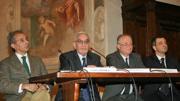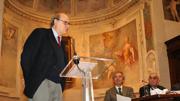
Project selection
Seven projects of great scientific value
In early 2006, the magnificent setting of Bramante’s sacristy in Milan, adjoining Leonardo’s Last Supper, hosted the official ceremony for the presentation of the 6 winning projects. Undertaken by broad partnerships coordinated by Milan University, Italy’s National Research Council, San Raffaele del Monte Tabor Foundation, Humanitas Foundation, and Pavia’s S. Matteo Polyclinic, these projects were awarded in the aggregate €12 million by Fondazione Cariplo. After the publication of the call for proposals, the project selection committee, that included Prof. Dulbecco, worked hard to shortlist the research centers that would be entrusted with the development of Fondazione Cariplo’s technology platforms for biomedicine.
In March 2007, Fondazione Cariplo started a partnership with Fondazione Cassa di Risparmio di Trento e Rovereto (CariTro) to pool their resources and fund a joint Bioinformatics platform. This platform rounded off the NOBEL Project in accordance with the guidelines and indications of the Scientific Committee.
Here is the list of the winning research projects proposed by partnerships formed by at least three highly authoritative organizations, and coordinated by scientists who operate within these organizations’ research centers:
- Professor Elena Cattaneo - Milan University received a €1 million grant for the project “A Genetic Toolkit For The Analysis Of Mouse Neural Stem Cells (Acronym: NS-Toolkit)”; Neural Stem Cells (Acronym: NS-Toolkit)”;
- Professor Roberto Sitia - San Raffaele del Monte Tabor Foundation and Professor Giampaolo Merlini - Pavia’s S.Matteo Polyclinic received a €3,500,000 grant for the project “Geno-proteomics of Age Related Disorders (GuARD)”;
- Professor Silvano Riva – National Research Council received a €924,000 grant for the project “Epigenetic Control Of Genome Stability “;
- Doctor Ileana Zucchi - National Research Council received a €3,300,000 grant for the project “Biological And Molecular Characterization Of Cancer Stem Cells”;
- Professor Alberto Mantovani - Humanitas Foundation received a €2 million grant for the project “Genetics And Functional Genomics Of Myelomonocytic Cells”;
- Doctor Paolo Vezzoni - National Research Council received a €1 million grant for the project “High-Tech Network For The Generation And Use Of Animal Models For Gene And Cell Therapy Of Human Diseases”.
- Professor Corrado Priami - The Microsoft Research - University of Trento Centre for Computational and Systems Biology received a €1,200,000 grant (€600,000 awarded by Fondazione Cariplo and €600,000 by Fondazione CariTro) for the project "Molecular Modeling in Gene Transcription, Translation and Regulation".
“The projects rewarded with grants – said Professor Renato Dulbecco – were conceived by outstanding scientists and were carefully selected by a high-profile scientific committee exclusively based on the project’s merits. I can personally guarantee this, since I presided over the selection process in my capacity as ‘observer’. I believe that with today’s completion of the first step, we have already achieved some of the objectives we had set ourselves. Research runs the risk of letting valuable projects run aground for lack of funds and resources. The concept I promoted and shared with Fondazione Cariplo’s Steering Board (Commissione Centrale di Beneficenza) was that of enlisting top-notch researchers and building technology platforms which instead of serving just a single research team would be used by numerous scientists capable of sharing their skills, professionalism, and intuitions as is the case, for instance, in the U.S. The Nobel project is also meant to help young scientists. Without them research will die out. Many of them go abroad for post-graduate training. I think this is right and helps open up one’s mind but afterwards it would be beautiful if these young researchers came back to Italy. We have to ask ourselves the crucial question of whether we have laid the groundwork for their comeback home. Today, also thanks to the Nobel project new opportunities are arising, a new future is taking shape.”
